|
 |
|
 |
 |
|
|
Tennis
Tennis is a sport played between two players (singles) or between two teams of two players each (doubles). Each player uses a strung racquet to strike a hollow rubber ball covered with felt over a net into the opponent's court.
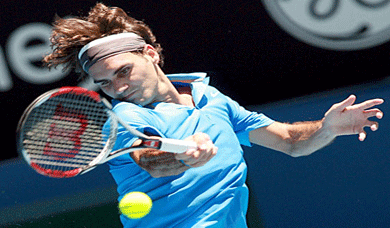 |
The modern game of tennis originated in the United Kingdom in the late 19th century as "lawn tennis" which has heavy connections to various field/lawn games as well as to the ancient game of real tennis. After its creation, tennis spread throughout the upper-class English-speaking population before spreading around the world[citation needed]. Tennis is an Olympic sport and is played at all levels of society at all ages. The sport can be played by anyone who can hold a racket, including people in wheelchairs. In the United States, there is a collegiate circuit organized by the National Collegiate Athletic Association.
The rules of tennis have changed very little since the 1890s. Two exceptions are that from 1908 to 1960 the server had to keep one foot on the ground at all times, and then the adoption of the tie-break in the 1970s. A recent addition to professional tennis has been the adoption of electronic review technology coupled with a point challenge system, which allows a player to challenge the line (or chair) umpire's call of a point.
Tennis enjoys millions of recreational players and is also a hugely popular worldwide spectator sport, especially the four Grand Slam tournaments (sometimes referred to as the "majors"): the Australian Open, the French Open, Wimbledon, and the US Open.
|
Tennis as the modern sport can be dated to two separate roots. According to some tennis historians, modern tennis terminology also derives from this period, as Wingfield borrowed both the name and much of the French vocabulary of real tennis and applied them to his new game.
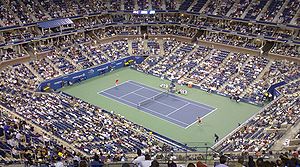 |
Lawn tennis in the U.S., 1887
The first American National tournament in 1880 was played there. On May 21, 1881, the United States National Lawn Tennis Association (now the United States Tennis Association) was formed to standardize the rules and organize competitions.The U.S. National Men's Singles Championship, now the US Open, was first held in 1881 at Newport, Rhode Island.The U.S. National Women's Singles Championships were first held in 1887. Tennis was also popular in France, where the French Open dates to 1891.Thus, Wimbledon, the US Open, the French Open, and the Australian Open (dating to 1905) became and have remained the most prestigious events in tennis.Together these four events are called the Majors or Slams (a term borrowed from bridge rather than baseball).
The comprehensive International Lawn Tennis Federation, now known as the International Tennis Federation, rules promulgated in 1924 have remained remarkably stable in the ensuing eighty years, the one major change being the addition of the tie-break system designed by James Van Alen. That same year, tennis withdrew from the Olympics after the 1924 Games but returned 60 years later as a 21-and-under demonstration event in 1984. This reinstatement was credited by the efforts by the then ITF President Philippe Chatrier, ITF General Secretary David Gray and ITF Vice President Pablo Llorens, and support from IOC President Juan Antonio Samaranch. In 1926, promoter C.C. Pyle established the first professional tennis tour with a group of American and French tennis players playing exhibition matches to paying audiences. The most notable of these early professionals were the American Vinnie Richards and the Frenchwoman Suzanne Lenglen. Once a player turned pro he or she could not compete in the major (amateur) tournaments.
In 1954, Van Alen founded the International Tennis Hall of Fame, a non-profit museum in Newport, Rhode Island. The building contains a large collection of tennis memorabilia as well as a hall of fame honoring prominent members and tennis players from all over the world.
|
| Name |
Description |
| No-ad |
The first player or doubles team to win four points wins the game, regardless of whether the player or team is ahead by two points. When the game score reaches three points each, the receiver chooses which side of the court (advantage court or deuce court) the service is to be delivered on the seventh and game-deciding point. |
| Pro set |
Instead of playing multiple sets, players may play one "pro set". A pro set is first to 8 (or 10) games by a margin of two games, instead of first to 6 games. A 12-point tie-break is usually played when the score is 8-8 (or 10-10). These are often played with no-ad scoring. |
| Match tiebreak |
This is sometimes played instead of a third set. This is played like a regular tiebreak, but the winner must win ten points instead of seven. Match tiebreaks are used in the Hopman Cup for mixed doubles, on the ATP and WTA tours for doubles and as a player's choice in USTA league play. |
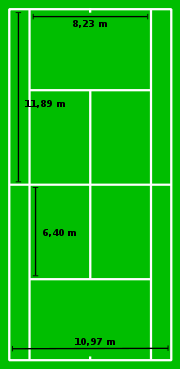 |
Another, however informal, tennis format is called "Kiwi doubles", "Canadian doubles" or "cut-throat". This involves three players, with one person playing a doubles team. The single player gets to utilize the alleys normally reserved only for a doubles team. Conversely, the doubles team does not use the alleys when executing a shot. The scoring is the same as a regular game. This format is not sanctioned by any official body.
"Australian doubles", another informal and unsanctioned form of tennis, is played with similar rules to the "Kiwi" style, only in this version, players rotate court position after each game. As such, each player plays doubles and singles over the course of a match, with the singles player always serving. Scoring styles vary, but one popular method is to assign a value of 2 points to each game, with the server taking both points if he or she holds serve and the doubles team each taking one if they break serve.
Wheelchair tennis can be played by able-bodied players as well as people who require a wheelchair for mobility. An extra bounce is permitted. This rule makes it possible to have mixed wheelchair and able-bodied matches. It is possible for a doubles team to consist of a wheelchair player and an able-bodied player (referred to as "one-up, one-down"), or for a wheelchair player to play against an able-bodied player. In such cases, the extra bounce is permitted for the wheelchair users only. |
Though strategy is important in singles, it is even more important in doubles. The additional width of the alleys on the doubles court has a great effect on the angles possible in doubles play. Consequently, doubles is known as a game of angles.
There are three basic doubles strategies:
both-up strategy (also called "two-up" strategy)
up-and-back strategy (also called "one-up/one-back" or "I" strategy)
both-back strategy (also called "two-back" strategy)
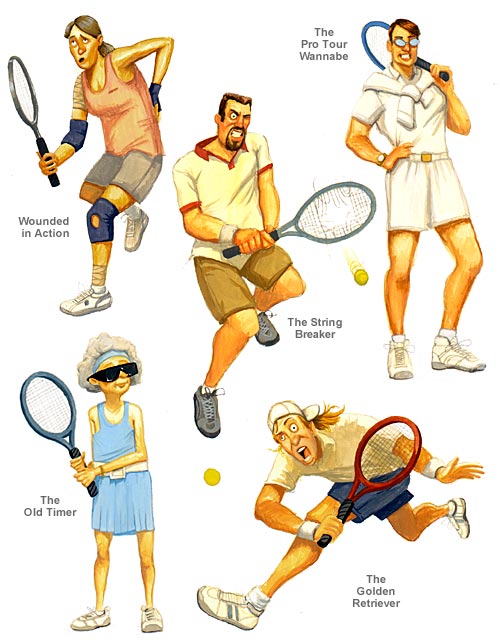 |
Both-Up Strategy
The ideal is both-up strategy, often called "Attacking Doubles" because the net is the "high ground", and both-up strategy puts both players close to it, in a position to score because of their excellent vantage points and angles. A team in the both-up formation, however, is vulnerable to a good lob from either opponent at any time. So, to be successful with Attacking Doubles, they must have penetrating volleys to prevent good lobs and good overhead shots to kill poor ones.
Teams that play Attacking Doubles try to get into the both-up formation on every point. When serving, their server follows most first serves to the net and some second serves. So, Attacking Doubles is also called serve-and-volley doubles. When receiving, their receiver follows most second-service returns to the net.
At the touring professional level, Attacking Doubles is the strategy of choice.
Up-and-Back Strategy
At lower levels of the game, not all players have penetrating volleys and strong overhead shots. So, many use up-and-back strategy. The weakness in this formation is the large angular gap it creates between partners, a gap that an opposing net player can easily hit a clean winner through.
Nonetheless, up-and-back strategy is versatile, with both offense and defense in it. In fact, since the server must begin each point at the baseline and the receiver must far enough back to return the serve, virtually every point in doubles begins with both teams in this formation.
Teams without net games strong enough to play Attacking Doubles can play both-up when they have their opponents on the defensive. So, they patiently play up-and-back for a chance to hit a forcing shot and bring their baseliner to the net.
Australian Doubles and the I-F
ormation are variations of up-and-back strategy. In Australian doubles, the server's partner at net lines up on the same side of the court, fronting the opposing net player, who serves as a poaching block and blind. The receiver then must return serve down the line and is liable to have that return poached. In the I-Formation, the server's net partner lines up in the center, between the server and receiver so he or she can poach in either direction. Both Australian Doubles and the I-Formation are poaching formations that can also be used to start the point for serve-and-volley doubles.
Both-Back Strategy
Both-back strategy is strictly defensive. It is normally seen only when the opposing team is both-up or when the returner is passing the net player on the return. From here the defenders can return the most forcing shots till they get a chance to hit a good lob or an offensive shot. If their opponents at net become impatient and try to angle the ball away when a baseliner can reach it, the defender can turn the tables and score outright. However this strategy leaves the volley court open to drop shots from the opposition.
|
Last Updated: September 14, 2009
| Men's Singles Rankings |
| RANK |
PLAYER |
COUNTRY |
POINTS |
| 1 |
Roger Federer |
Switzerland |
11240.0 |
| 2 |
Rafael Nadal |
Spain |
8845.0 |
| 3 |
Andy Murray |
Great Britain |
8390.0 |
| 4 |
Novak Djokovic |
Serbia & Montenegro |
7480.0 |
| 5 |
Juan Martin del Potro |
Argentina |
6825.0 |
| 6 |
Andy Roddick |
USA |
5310.0 |
| 7 |
Jo-Wilfried Tsonga |
France |
3950.0 |
| 8 |
Nikolay Davydenko |
Russia |
3535.0 |
| 9 |
Fernando Verdasco |
Spain |
3430.0 |
| 10 |
Gilles Simon |
France |
3090.0 |
| 11 |
Robin Soderling |
Sweden |
3015.0 |
| 12 |
Fernando Gonzalez |
Chile |
2885.0 |
| 13 |
Gael Monfils |
France |
2355.0 |
| 14 |
David Nalbandian |
Argentina |
2225.0 |
| 15 |
Marin Cilic |
Croatia |
2195.0 |
| 16 |
Tommy Robredo |
Spain |
2045.0 |
| 17 |
Radek Stepanek |
Czech Republic |
2030.0 |
| 18 |
Tomas Berdych |
Czech Republic |
2025.0 |
| 19 |
David Ferrer |
Spain |
1785.0 |
| 20 |
Tommy Haas |
Germany |
1780.0 |
| 21 |
Juan Carlos Ferrero |
Spain |
1670.0 |
| 22 |
Stanislas Wawrinka |
Switzerland |
1555.0 |
| 23 |
Philipp Kohlschreiber |
Germany |
1530.0 |
| 24 |
James Blake |
USA |
1460.0 |
| 25 |
Sam Querrey |
USA |
1390.0 |
| 26 |
Lleyton Hewitt |
Australia |
1375.0 |
| 27 |
Paul-Henri Mathieu |
Australia |
1330.0 |
| 28 |
Victor Hanescu |
Romania |
1286.0 |
| 29 |
Dudi Sela |
Israel |
1244.0 |
| 30 |
Nicolas Almagro |
Spain |
1225.0 |
| 31 |
Ivo Karlovic |
Croatia |
1220.0 |
|
- Grand Slam Winners: There were only five people to win The Grand Slam. Winning The Grand Slam means winning all four Grand Slams (the Australian Open, the French Open, Wimbledon, and the United States Open) in the same year. The people to accomplish this feat were: Don Budge in 1938, Maureen Connolly in 1953, Rod Laver in 1962 and 1969, Margaret Court in 1970, and Steffi Graf in 1988.
- Tennis Balls: Yellow tennis balls were used at Wimbledon for the first time in 1986.
- Longest Match: At the 2004 French Open Fabrice Santoro and Arnaud Clement (both French) played the longest match since the Open era of professional tennis began in 1968. The match began on Monday, May 24 but play was suspended in the 5th set when darkness fell. The game resumed the next day and Santoro finally beat Clement 16-14 to win the fifth set. The 71 game marathon lasted a total of 6 hours and 33 minutes on court, beating the former record of 6:22 played by John McEnroe and Mats Wilander at the 1982 Davis Cup.
- Fastest Man Serve: The fastest serve officially recorded lies with American player Andy Roddick, at 155 mph, or 249.4 kph. It happened on September 27, 2004 in a Davis Cup match against Belarus. Roddick was playing Vladimir Voltchkov and the serve set him up with three match points. Needless to say, it was an ace!
- Fastest Women's Serve: The fastest server in the women's tennis was done by Venus Williams who recorded a serve of 205 km/h (127.4 mph) during the European Indoor Championships.
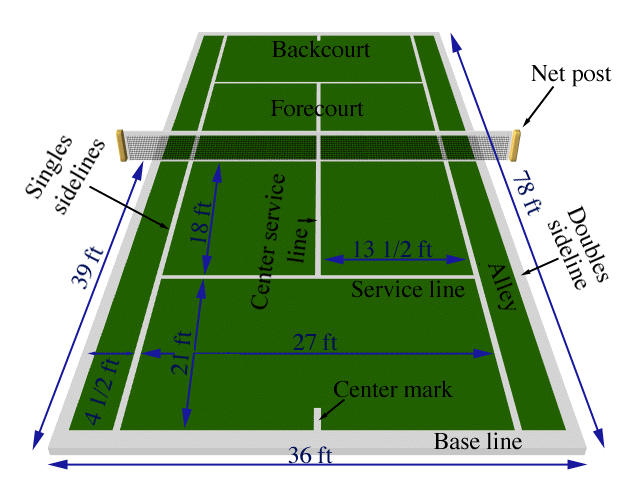 |
- Roger Federer: He holds many records in the game, including having appeared in ten consecutive Grand Slam men's singles finals (2005 Wimbledon Championships through to 2007 U.S. Open). He also holds the open era records for consecutive wins on both grass courts (with 62) and hard courts (58).
- Start of Open Era: Tennis open era started in 1968
- Martina Hingis: holds many »youngest« records:
- the youngest player to win a match in a Grand Slam – aged 14
- the youngest Grand Slam winner – partnered with Helena Sukova and won
Wimbledon doubles title – aged 15
- youngest Grand Slam winner in 20th century
– won Australian Open – aged 16
- youngest player to attain nr. 1 ranking – aged 16
- youngest Wimbledon champion – aged 16
- The longest known singles game: was one of 37 deuces (80 points) between Anthony Fawcett (Rhodesia) and Keith Glass (Great Britain) in the first round of the Surrey, Great Britain Championships at Surbiton, Surrey, Great Britain on 26 May 1975. It lasted 31 min.
- Most Grand Slam Tennis Titles Won By a Man: The most Grand Slam singles tennis titles won by a man is 14, by Pete Sampras of the USA, between 1990 and 2000.
- Most ATP Tour Championship Singles Wins: Czechoslovakia's Ivan Lendl won five titles: in 1982, 1983, 1986 (two), and 1987, appearing in nine successive finals between 1980 and 1988.
- Highest Earnings In Tennis: Pete Sampras pocketed a phenomenal $41,994,440 during his career when he turned professional in 1988 to August 2001.
|
|
|
|

|
|
